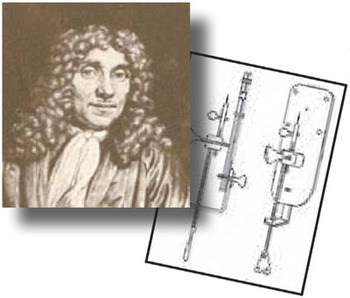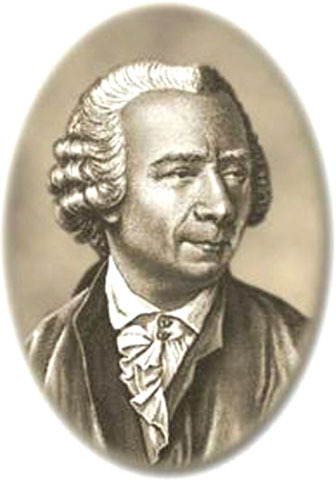
Leonhard Euler (1707-1783)
Leonhard Euler is best known as a prolific mathematician, but he also made notable contributions in optics and astronomy. He was born in Basel, Switzerland on April 15, 1707, the son of Paul Euler, a Protestant minister, and Margaret Brucker, the daughter of a Protestant minister. Accordingly, Leonhard Euler was raised to follow suit and join the ministry, but his father had sparked his interest in mathematics at a young age, and this interest was further cultivated at the University of Basel, which he entered at the age of fourteen. His prodigious ability in the field impressed renowned mathematics professor Johann Bernoulli, who allowed Euler to visit with him on Sundays to discuss any difficulties the young scholar had in understanding the advanced books on mathematics that he had recommended. Nevertheless, even in 1723, Euler still appeared to be set on a course that would lead him to the church, having gained his Master's degree in philosophy and embarked on studies of theology. Soon after, however, with the help of Bernoulli, Euler convinced his father to permit him to study mathematics instead.

In 1726, Euler completed his studies and began seeking an academic appointment, which he quickly received from the St. Petersburg Academy of Sciences. Though he would have preferred to stay at Basel and was hoping to be presented a post there before he left for Russia, none was offered to him, perhaps because he was still only nineteen years old. Thus, he arrived in St. Petersburg in 1727 and enlisted with the Russian navy, of which he was required to remain a member until 1730, when he was made a full member of the academy. Three years later Euler's fortune improved to an even greater extent when the senior chair of mathematics at the institution, Daniel Bernoulli, decided to return to Switzerland, and his position was given to Euler. The additional income from this appointment made it possible for Euler to marry Katharina Gsell, the daughter of a Swiss artist. Over the course of their marriage, the couple would have thirteen children, five of which would survive infancy. In 1741, when Russia was in a state of political flux, the family relocated to Germany so that Euler could take a position as professor of mathematics at the Berlin Academy of Sciences, but they eventually returned to St. Petersburg in 1766 at the behest of Catherine the Great.
Euler's mathematical achievements are numerous and varied. As an example, he established a set of equations (known as Euler equations) describing fluid mechanics that stemmed from Isaac Newton's laws of motion, formed the theory of trigonometric and logarithmic functions, and developed the important mathematical concept of a function. He also introduced many forms of mathematical notation that are still in use today, made significant contributions to number theory, and solved the famous seven bridges of Königsberg problem, which concerned whether or not the bridges connecting the two islands and the mainland of the city of Königsberg could be traversed in such a way that no bridge was crossed more than once and the starting point was also the ending point. Though most of his work was focused on pure mathematics, he also applied his analytical skills to other areas. He was particularly interested in lunar motion and made significant improvements in the theory used to explain and predict such motion. His contributions to the area allowed the calculation of more accurate lunar tables, which were commonly used then by sailors to determine longitude. He also attempted to apply mathematics to music, but his ideas in this area were not well received.
In optics, Euler entered the debate on the nature of light and argued, contrary to the more popular view at the time, that light was not composed of particles. Instead, Euler's theory of light was founded upon the existence of ether, which he believed served as a pervasive medium for light vibrations. As Euler and many other later scientists viewed the matter, the phenomenon of diffraction could be more readily explained by a wave theory of light. Though it was eventually proved in the late 1800s that ether does not exist, many of Euler's other views on optics turned out to be correct. For example, although Isaac Newton had declared it theoretically impossible to produce achromatic lenses, Euler disagreed based on the fact that the eye is composed of lenses that can create a near-perfect image. Moreover, Euler proved his case that certain combinations of lenses with different refracting characteristics could correct aberration through analytical means, though he was never able to actually build the achromatic system he suggested. Much of Euler's work on light was published in the three-part work Dioptrica, the first volume of which was published in 1769. Within Dioptrica, the properties of lenses are discussed, the groundwork for the calculation of optical systems is established, and descriptions of microscopes and telescopes are provided.
Euler's output of mathematical and scientific works is practically unequaled by any other scholar in history. He published more than 500 works during his lifetime, and at least another 400 were released after his death in 1783. Producing such an extensive body of scholarly material was somewhat detrimental to Euler's health, and eyestrain is often considered to have greatly contributed to Euler losing his eyesight, first in one eye and then in the other as well, leaving him completely blind in his later years. The fact that his blindness did not hinder his work, which he continued to carry out with the help of family members and assistants, is a testament to his outstanding memory and exceptional ability to carry out complex calculations in his head. Up to the very day he died, on September 18, 1783, Euler pursued the solutions to mathematic and scientific questions with an uncommon insight and determination.
Étienne-Louis Malus (1775-1812)
Étienne-Louis Malus was born in Paris, France, and displayed significant ability in mathematics while attending the military engineering school at Mezires. He was dismissed from the establishment, however, without a commission in 1793 on political grounds. Subsequently, Malus entered the French army as a private soldier and eventually gained notice for his skills, which resulted in his superiors selecting him to study at the École Polytechnique. A pupil of Jean-Baptiste-Joseph Fourier, while enrolled at the state supported institution Malus began carrying out research in optics focusing on the refractive indices of various materials. Once he received his degree, Malus was accepted into the army's corps of engineers but remained associated with the École Polytechnique as an examiner. Malus took part in Napoleon's campaigns in Egypt and Syria in 1798 and did not leave the region until 1801.

Although he continued to hold official posts in the military for many years, Malus became increasingly involved in the study of optics following his return from the East. In 1807, he commenced experiments on double refraction, the phenomenon that causes a light beam to divide into two different rays on passing through certain materials, such as Iceland spar. Malus's findings supported those obtained earlier by Dutch scientist Christiaan Huygens whose description of double refraction was founded upon the then controversial idea that light is characteristically wavelike. In 1808, Malus famously discovered that light could be polarized—a term coined by Malus—by reflection as he observed sunlight reflected from the windows of the Luxemburg Palace in Paris through an Iceland spar crystal that he rotated. He followed the discovery with additional experiments, which demonstrated that the capacity to polarize light was not limited to Iceland spar and other special types of crystals, but that the reflections from most ordinary substances could also produce the effect. Malus's work on polarization was published in 1809, and in 1810, his theory of double refraction of light in crystals appeared in print as well.
Included among Malus's published work is Malus's law, a mathematical means of predicting the intensity of light transmission through a pair of polarizing filters. The equation, which is a function of the angles between the polarizer transmission axes, is usually written as follows:
where I is the intensity of light passing through the analyzer (and the total amount of light passed through the pair of crossed polarizers), I 0 is the intensity of light that is incident upon the polarizer, and θ is the angle between the transmission axes of the polarizer and analyzer. Using this equation, it can be determined, for instance, that when the two polarizers are crossed (θ = 90 degrees), the intensity is zero, meaning that all light passed by the polarizer is completely extinguished by the analyzer.
For his groundbreaking efforts in optics, Malus was honored with many awards. Most notably, he received the accolades of the French Académie des Sciences, to which he was elected as a member soon after his double refraction research, and the Rumford medal of the Royal Society of London, a surprising tribute because France and England were at war at the time. Despite his great potential for additional contributions to the field of optics, Malus's life ended prematurely soon after his most famous discoveries, on February 23, 1812. He reportedly succumbed to an illness, possibly tuberculosis, that he contracted many years earlier while on a military campaign.


